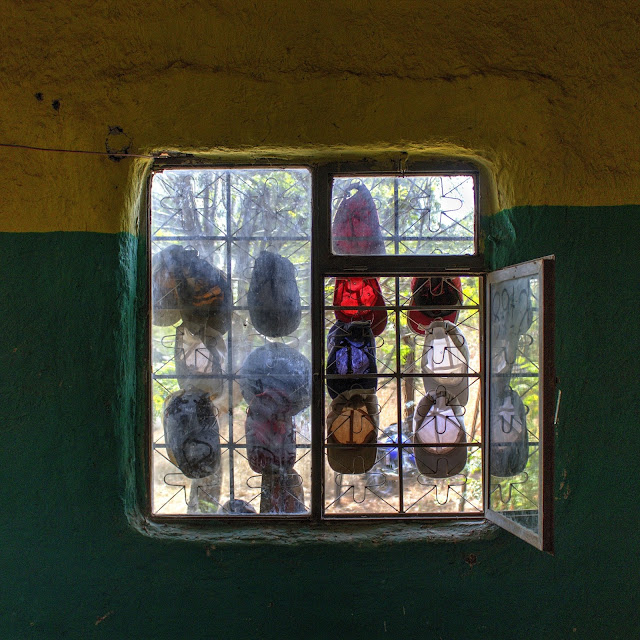The ancient city of Aksum (sometimes spelled Axum) in northern Ethiopia is famous for these granite carvings called stele. They date back to the 1st to 4th century and were made as grave markers for famous kings. In the foreground of this photo you can see the largest one which has fallen over.
These stele were carved from a single piece of stone and the largest is about 30 meters tall.
Archeologists still do not know how the ancient Ethiopians managed to erect these obelisks.
The stele on the left was located in Rome until 2002 when the Italian government returned it to Ethiopia in three large pieces.
The stele at night.
This small green chapel is in Aksum across from where the stele are located. The Ethiopian Orthodox Church claims that the Ark of the Covenant is located inside. Obviously, you are not allowed inside. In fact, men can go no closer to the building than about 40 yards and women no closer than 100.
Inside a male-only church next to the chapel with the Ark of the Covenant.
Lalibela is possibly the most famous place in Ethiopia, and rightly so. It is famous for these rock-hewn churches. This one, the Church of St. George, is the prettiest and most well designed of the dozen carved churches. It is three stories high and has been carved straight down into the rock.
This is a view of St. George from ground level. You can see how the churches were carved straight down into the rock.
Since the rock-hewn churches are located in the ground you descend to the churches through these carved channels that crisscross the area. There are many small rooms and caves for pilgrims and monks to live and pray in.
Another one of the rock-hewn churches. The bricks on the right are from a restoration.
One of the many small rooms and caves for pilgrims.
Pilgrims gather outside of one of the churches for a Good Friday service.
A view of Lalibela and its surrounding area from 10,000ft above sea-level.
Seriously, the area around Lalibela was possibly the most beautiful area I have ever seen. This was the view from the back of our hotel in Lalibela.
Some other missionary friends and I on a weekend trip to Lake Langango in southern Ethiopia.
Lake Langango itself.
There were many monkeys and other wildlife around Lake Langango.
For a friend's bachelor party, we went camping near Lake Wenchi, about three hours from Addis.
The stream next to where we were camping bubbled with naturally carbonated water.
The area around Lake Wenchi was surreal. You can see a water powered mill in this photo.
This is a view of the Ethiopian landscape from a place about an hour north of Addis Ababa.
A week ago I check the last thing off of my Ethiopia bucket list. I ate kitfo! Kitfo is a raw beef that is minced, spiced, and eaten with injera. I found it delicious, and, thankfully, I did not get sick from the raw meat.

























































